Featured Application
The present work, based on a multivariate approach, may represent a rapid, effective, and low-cost tool, preliminary to genetic analysis, for the assessment of the traceability and quality of Castanea spp. nuts with no information on their origin.
Abstract
The phytochemical characterization of Castanea spp. fruits is very important for the development of effective strategies for the biodiversity conservation and traceability of chestnuts, as the chestnut is one of the most important Italian and European nut and forest species. In this study, several cultivars of C. sativa (sweet chestnuts and “marrone-type”), C. crenata, and hybrids of C. sativa × C. crenata were characterized by spectrophotometric (Folin–Ciocalteu assay for the total polyphenolic content and ferric reducing antioxidant power test for the antioxidant capacity) and chromatographic (high-performance liquid chromatography coupled to a diode array UV-Vis detector) protocols to define their phytochemical composition and nutraceutical properties. The phytochemical results were then used to build a multivariate statistical model (by principal component analysis) and obtain an effective and rapid tool to discriminate unknown cultivars (i.e., no information about their origin) belonging to different species. The multivariate approach showed that the genotype was a significantly discriminating variable (p < 0.05) for the phytochemical composition. Polyphenols (in particular, phenolic acids and tannins) have been identified as the main bioactive classes with the highest discriminating power among the different genotypes. The total polyphenol content (TPC) and antioxidant capacity (AOC) showed a rich presence of bioactive compounds (74.09 ± 15.10 mgGAE 100 g−1 DW and 11.05 ± 1.35 mmol Fe2+ kg−1 DW, respectively), underlining the potential health benefits and functional traits of chestnuts. The principal component analysis applied to phytochemical variables has proved to be an excellent and effective tool for genotype differentiation to be used as a preliminary method for identifying the species of Castanea spp. fruits with an unknown origin. The present study showed that a multivariate approach, based on phytochemical data and preliminary to genetic analysis, may represent a rapid, effective, and low-cost tool for the traceability and quality evaluation of chestnuts from different species and hybrids with no information on their origin.
1. Introduction
The chestnut has always represented an excellent multi-functional resource for many countries in the world. Centuries of co-existence influenced the territory and the genetic performance of the Castanea genus, particularly adaptable and diversified [1], configuring a production sector with specific traits. The form and tree shape of Castanea spp. are different. C. sativa (European chestnut) are tall, slender, and upright plants; they can exceed 30 m height (400 years of age) and be very vigorous. Other species have round foliage and a smaller size. In particular, C. crenata (Japanese chestnut) does not normally exceed 8–10 min in height, even if it can reach 15 m, and 60 cm in diameter [1].
The most valuable species is the European chestnut (C. sativa), especially the “marrone-type” chestnut, characterized by a high price in the market. However, from the late 19th century to nowadays, chestnut orchards have been endangered by the spread of pests and diseases, such as ink disease (Phytophthora cambivora), cortical cancer (Cryphonectria parasitica), and Asian chestnut gall wasps (Dryocosmus kuriphilus), because of a rapidly changing environment. Therefore, many traditional cultivars have been replaced by Euro-Japanese hybrids (C. sativa × C. crenata), such as “Bouche de Betizac”, to improve the resistance to gall wasps and increase plant density [2]. Compared to sweet chestnuts and “marrone-type” chestnuts, these hybrids have early production, larger nuts, high moisture content, and they are often polyembryonic; thus, they are more suitable for fresh consumption than for “marrons glacés” or industrial processing [3].
The economic interest for Castanea spp. nuts in the food industry increased the demand for selected cultivars, which is also driven by several research studies on the potential positive health benefits that can be derived from the consumption of fresh and processed chestnut products. Chestnuts are nutritionally very similar to wheat or rice. The water content is quite modest (about 50%). Fresh chestnuts have a high calorie content (150–230 kcal for every 100 g of edible product); good fibre content (7–8%); excellent carbohydrate content (about 35–50%); a fair quality protein content (from 1.60 to 4.20 g/100 g); a low fat percentage (0.53–1.25 g/100 g); and a moderate percentage of mineral elements, such as potassium (320–490 mg/100 g), calcium (15–30 mg/100 g), sodium (2–15 mg/100 g), and phosphorus (30–100 mg/100 g); it also has a good content of hydrosoluble vitamins (e.g., C, B1, and B2) [4]. It is very important to preserve and valorize traditional genotypes and their typical uses, reducing the loss of local germplasm. In Italy, there are 231 local traditional cultivars (data from National Register of Fruit Trees, 2020) and 15 Protected Designation of Origin (PDO) and Protected Geographical Indication (PGI) products. The study of Alessandri et al. [5] showed a high level of differentiation among the sweet chestnuts, frequently propagated by seeds, and a good similarity to the wild chestnuts; on the other hand, “marrone-type” chestnuts present a more homogeneous genome due to the clonal propagation, applied to preserve high-quality productions.
The increased market demand and consumer awareness stimulate the development of reliable methods for the cultivar description and identification, and for the characterization of the fruit traits for the selection of high-quality products (e.g., good sensorial and qualitative properties, high bioactive compound content) [4]. Many studies to protect and valorize traditional ecotypes have developed methods for traceability, based on genetic analysis [5,6,7] or using near-infrared spectroscopy coupled with chemometrics [8]. In combination with agronomic and morphological observations, the use of microsatellite molecular markers has also highlighted the geographical distribution of allelic richness and phenotypic variation in the stress response of chestnut populations, defining suitable breeding areas [9,10,11,12].
The chestnut agrobiodiversity influences nut composition, nutritional and technological traits, and the synthesis of secondary metabolites with high nutraceutical potential, as emerged from several chemical studies [4,13,14,15,16]. Therefore, it is very important to recognize the factors that mainly influence the chestnut quality to select the best cultivars and agrotechniques, according to pedoclimatic conditions and commercial use (e.g., fresh market, industrial processing, livestock feed, etc.). Moreover, the phytochemical characterization of fruits from Castanea spp. may be very important for the development of effective strategies for the biodiversity conservation and traceability valorization of chestnuts.
This study aimed to provide a traceability tool based on secondary metabolite quantification that may be effective and rapid in discriminating cultivars and selecting the most interesting one for a specific purpose. Chromatographic and spectrophotometric analyses were performed to define the nut composition (phytochemical fingerprint), as well as verify and quantify the content of antioxidant compounds useful to prevent chronic diseases and important in preservation and transformation processes [17,18]. The obtained results were used to define the structure of a predictive and screening model by a multivariate statistical approach (principal component analysis) to distinguish cultivars with unknown origins based on genotype (“species” level), reducing the number of samples to be subjected to genetic analysis, with cost and time savings.
2. Materials and Methods
2.1. Plant Material
From September to October 2021, chestnuts were collected from the germplasm repository (Castanetum) of the Chestnut R&D Center—Piemonte, located in Chiusa di Pesio (CN) in Piedmont (North-Western Italy) (44°19′ N, 7°40′ E; elevation 575 m above sea level). The area is characterized by a temperate climate, with an average annual rainfall of approximately 1350 mm, very important for the high-water requirements of Castanea spp. (Figure 1).
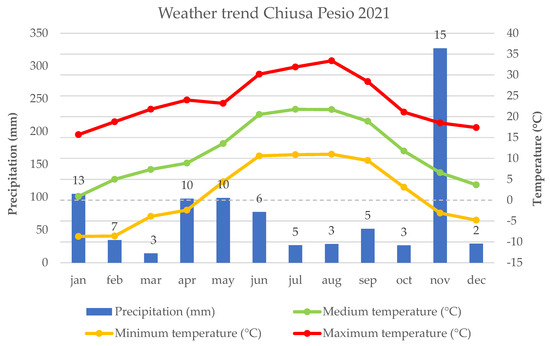
Figure 1.
Meteorological data recorded in 2021 by the weather station located in the Castanetum; the numbers above the columns indicate the number of rainy days in the corresponding month. Source: ARPA Piedmont.
The soil is classified as a well-draining Entisol with a sandy-loam texture, abundant in the skeleton (>35%), but with limited depth (<25 cm). Despite this limitation, moderate summer temperatures and high rainfall in the area enable a balanced growth of the trees. Additionally, the soil is favorable for the growth of chestnut trees because of its very low levels of carbonates and a pH range between 4.5 and 6.5.
In the Castanetum, the plants grow up in the same pedoclimatic conditions and they are grafted on the same clonal rootstock, significantly reducing their variability due to environmental factors, and highlighting the differences derived from the genotype. The orchard layout is 8.0 m × 11.5 m and each cultivar is represented by 3 individuals. The inter-row is grassed and the row is covered with mulch; irrigation is only for emergency purposes.
The fruits were grouped in accordance with their genotype in four groups: Japanese chestnuts (C. crenata), Euro-Japanese hybrids (C. sativa × C. crenata), and European chestnuts (C. sativa sweet chestnuts and C. sativa “marrone-type”), as shown in Table 1.

Table 1.
List of Castanea species and respective cultivars subject to analysis.
After a manual sampling, the fruits of each cultivar were stored at 4 °C and 95% relative humidity and gradually used for the extract preparation before chemical analysis.
2.2. Sample Preparation
The fruits were manually peeled, removing the pericarp and episperm. The raw nuts were cut into regular cubes (about 4 × 4 mm) until there was a weight of approximately 150 g for each sample, dried in an oven at 40–50 °C for 48 h until a stable weight was achieved, and then ground to fine pounder, which was stored at room temperature in sealed plastic bags until extraction.
2.3. Extraction Protocols
Polyphenols, monoterpenes, and organic acids were extracted with a mixture of methanol, deionized water, and 37% hydrochloric acid (95:4.7:0.3, v/v/v) through pre-injection filtration using circular filters (0.45 μm PTFE membrane). Sugars were extracted through maceration in an 80% ethanol solution. Following homogenization and centrifugation, the samples were stored at 4 °C with 95% relative humidity until analysis. Ascorbic and dehydroascorbic acid were extracted through a solvent composed of hydrochloric acid (0.1 M), ethylenediaminetetraacetic acid (EDTA, 0.05%), and sodium fluoride (4 mM) in 5% methanol and 95% deionized water. The two components of vitamin C (ascorbic and dehydroascorbic acids) were determined separately by adding o-phenylenediamine (OPDA), which reacts with dehydroascorbic acid to form 3-(1,2-dihydroxy ethyl)furo [3,4-b]quinoxaline-1-one (DFQ).
2.4. Spectrophotometric Analysis
The method applied for the quantification of total phenols (TPC) follows the Slinkard and Singleton protocol [19] with the Folin–Ciocâlteu reagent. The results were expressed in equivalents of gallic acid (GAE) per 100 g of dry product (DW). The absorbance was measured at a wavelength of 760 nm with ultraviolet/visible (UV-Vis) spectrophotometry. The antioxidant activity (AOC) was evaluated through the FRAP (ferric reducing antioxidant power) assay according to the Benzie and Strain method [20], modified by Pellegrini et al. [21]. The obtained values were expressed in millimoles of Fe2+ ions per kg of dry product (DW). The quantification was carried out by spectrophotometry at a wavelength of 595 nm.
2.5. Chromatographic Analysis
Chromatographic analysis was performed using an Agilent Technologies HPLC system (series 1200) coupled with a UV-Vis diode array detector (Santa Clara, CA, USA). Six different chromatographic methods were followed (reported in Supplementary Materials, Table S1).
The quantification of analytes was performed using external standard calibration curves; standard solutions were prepared at known concentrations for each analyte of interest, according to Donno et al. [22]. In total, the selected compounds were 31, expressed in mg/100 g of dry product (DW) or g/100 g of DW (in the case of sugars): 5 classes of polyphenols (benzoic acids, cinnamic acids, catechins, tannins, and flavonols), vitamin C (ascorbic and dehydroascorbic acids), monoterpenes, organic acids, and sugars.
2.6. Data Analysis
The results of the chemical analyses were subjected to a one-way analysis of variance (ANOVA), followed by Tukey’s honest significant difference (HSD) post-hoc test, to determine statistically significant differences (p ≤ 0.05) among the cultivars for each investigated molecule. IBM SPSS Statistics 22.0 was used for statistical calculations. Moreover, a multivariate principal component analysis (PCA) on the correlation matrix (Varimax rotation) was also performed using Minitab 18.0 to observe the distribution of the considered cultivars and their correlations based on their chemical composition. Bartlett’s test of sphericity (BTS) and the Kaiser–Meyer–Olkin index (KMO) were used on the same matrix. The phytochemical variables (TPC, AOC, phytochemical classes) were standardized (Z-score) and recombined based on their level of correlation into principal components corresponding to an eigenvalue greater than or equal to 1 and capable of explaining at least 60% of the total variance. First, PCAs were individually performed on each genotype group (C. sativa sweet chestnuts and “marrone-type”, Euro-Japanese hybrids, and Japanese chestnuts) to detect the most representative cultivar for each group. A second PCA was then carried out using the cultivars selected from the previous multivariate analysis to define a statistical preliminary model for the traceability evaluation and the detection of the genotype (“species” level) of unknown samples.
3. Results
3.1. Total Polyphenol Content and Antioxidant Capacity
Chestnuts are excellent sources of bioactive compounds and are low in fat content if compared with other nuts (almonds, hazelnuts, and walnuts). Since healthiness has become an important trait that influences the purchase and consumption of food products over recent decades [23], it is relevant to highlight the quality of chestnuts and their potential as functional foods. One of the most important phytochemical classes of secondary metabolites in plants is polyphenols. They are the main group of biologically active non-nutrients detected in plant materials and foods, which have antioxidant, anti-bacterial, and anti-cancer properties, and protective effects against several chronic diseases [24]. Previous studies have reported values ranging from 196 to 431 mgGAE 100 g−1 dry weight (DW) in Spanish cultivars [25], a range from 500 to 3282 mgGAE 100 g−1 DW in Turkish cultivars [26], and a range from 103 to 219 mgGAE 100 g−1 DW in C. mollissima cultivars [27], demonstrating a high TPC variability in the fruits of Castanea spp. On the same cultivar, “Judia”, Dinis et al. [28] found that the extracts from the coldest location had 50.5% more total phenolics content than the ones from the hottest location, showing a significant impact of climatic environmental factors on the synthesis of polyphenols. Moreover, most of the genotypes presented polyphenolic levels similar to hazelnut ones [29,30] and higher than walnut ones [31]. In the present study, different cultivars are grown on the same clonal rootstock and in the same pedoclimatic and agronomic conditions to evaluate the genetic differences. Figure 2 and Figure 3 show the total polyphenol content (TPC) and antioxidant capacity (AOC) values for a selection of cultivars. Figures S1 and S2 (Supplementary Materials) report the values for all the analyzed cultivars.

Figure 2.
Total polyphenol content of 35 selected chestnut cultivars. Different letters for each cultivar indicate the significant differences at p < 0.05. Red color: “marrone-type” chestnut (MT); purple color: sweet chestnut (SC); orange color: Euro-Japanese hybrid (EH); blue color: Japanese chestnut (JC). The dashed line indicates the average.
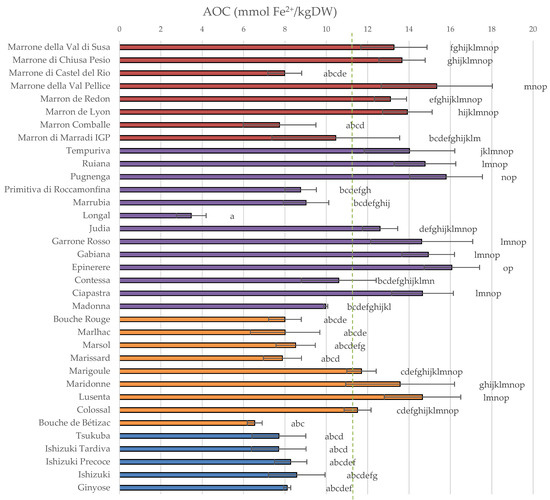
Figure 3.
Antioxidant activity of 35 chestnut cultivars. Different letters for each cultivar indicate the significant differences at p < 0.05. Red color: “marrone-type” chestnut (MT); purple color: sweet chestnut (SC); orange color: Euro-Japanese hybrid (EH); blue color: Japanese chestnut (JC). The dashed line indicates the average.
The obtained TPC mean values (Figure 2) ranged from 191.44 ± 17.95 mgGAE 100 g−1 DW, for the flour derived from “Ruiana” cv (Piemonte Region), to 28.72 ± 16.56 mgGAE 100 g−1 DW, for the Tuscan cultivar “Marrone di Marradi”, in accordance with previous studies [4,13]. Overall, Japanese chestnuts presented lower values than the other chestnuts (with an average of 59.03 mgGAE 100 g−1 DW), followed by the “marrone-type” group (e.g., the French cultivar “Marron de Lyon” presented a TPC value of 176.26 ± 15.44 mgGAE 100 g−1 DW, similar to the higher values of sweet chestnuts and Euro-Japanese hybrids). In agreement with Ciucure et al. [14], “Marissard” cv showed the highest TPC value in Euro-Japanese hybrids (163.91 ± 15.23 mgGAE 100 g−1 DW). It is worth noting that, as the study of Uzun [32] reported, total phenolics decrease during cold storage after the harvesting; therefore, this aspect may have affected the measures.
The antioxidant capacity (AOC) is generally due to the content of polyphenols, vitamins, monoterpenes, and organic acids. These free-radical scavenging antioxidants prevent functional loss and damage to biological membranes, detoxify enzymes, maintain health, and reduce the risk of disease [33]. To evaluate this parameter, there are several methods, which give different units of measurement, so it is difficult to compare the values with earlier studies. In the present work, the FRAP assay was applied; this method assesses the reduction of metal ions; even if it underestimates the real biological antioxidant capacity and the synergistic health-promoting properties, this screening method was used because it is simple, low-cost, and fast. The FRAP value (expressed as ferrous iron equivalents) allows an efficient comparison of different samples of natural products [34]. The obtained results (Figure 3) showed that all the Japanese cultivars had similar values, lower than the average of the other groups. The Euro-Japanese hybrids were more similar to the European chestnuts, with good AOC in the “Lusenta” cv (14.65 ± 1.85 mmol Fe2+ kg−1 DW) and “Maridonne” cv (13.57 ± 2.63 mmol Fe2+ kg−1 DW). The lowest value was detected in “Bouche de Bétizac” cv (6.54 ± 0.36 mmol Fe2+ kg−1 DW), as also reported by Beccaro et al. [4], and in the Portuguese “Longal” cultivar (3.47 ± 0.72 mmol Fe2+ kg−1 DW). Among the C. sativa cultivars, “Epinerere” had 16.07 ± 1.34 mmol Fe2+ kg−1 DW, followed by “Pugnenga”. The cultivars “Ciapastra”, “Gabiana”, “Garrone Rosso”, and “Ruiana” showed statistically similar values. “Marrone-type” cultivars presented a good antioxidant capacity, similar to sweet chestnuts, with a maximum value in “Marrone della Val Pellice” cv (15.34 ± 2.69 mmol Fe2+ kg−1 DW).
3.2. Phytochemical Composition and Nutritional Properties
The phenolic compounds were grouped into the following classes to define the contribution of each class to the total polyphenolic composition: benzoic acids (ellagic acid and gallic acid), cinnamic acids (caffeic, coumaric, ferulic, and chlorogenic acids), catechins (catechin and epicatechin), flavonols (hyperoside, isoquercitrin, quercetin, quercitrin, and rutin), and tannins (castalagin and vescalagin). Quercetin and quercitrin were not detected in chestnut extracts, whereas gallic acid was only quantified in very small amounts in the Japanese cultivar “Ginyose”. The complete phytochemical composition in chestnut extracts is shown in Table S2 (Supplementary Materials).
The results showed a predominance of cinnamic acids in comparison to flavonols (Table S2) in all the analyzed chestnut groups. European chestnuts presented the highest values of cinnamic acids, in particular, the sweet chestnut cultivar “Pugnenga” (62.89 ± 0.22 mg 100 g−1 DW). Generally, chlorogenic acid was the main component, as reported in Figure 4, except in “Ishizuki Tardiva” (in this cultivar, it was not detected). The mean amount of chlorogenic acid in Euro-Japanese hybrids (10.88 mg 100 g−1 DW) was higher than the data reported by Ciucure et al. [14] for the same cultivars, suggesting that the geographic location played a significant role. This compound can be also found in green coffee extracts and tea, and it has been investigated in several medical studies. It was demonstrated that chlorogenic acid is an antioxidant agent and it can perform crucial roles in lipid and glucose metabolism regulation, contributing to weight reduction and the prevention of obesity-related diseases [35].
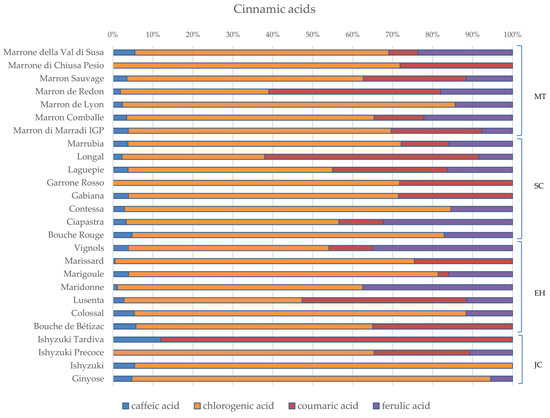
Figure 4.
Cinnamic acids profile of 26 chestnut cultivars. The lines to the right indicate different groups: “marrone-type” chestnut (MT); sweet chestnut (SC); Euro-Japanese hybrid (EH); Japanese chestnut (JC).
Flavonols, mainly hyperoside, were detected in trace amounts or were absent in Japanese chestnuts, as well as in Euro-Japanese hybrids; significant amounts were only identified in “Lusenta” cv. On the other hand, the class was detected, although in low amounts, in most of the European chestnuts. Hyperoside seems to be an effective protection against inflammatory vascular damage; thus, it may be useful in the treatment of severe vascular inflammatory diseases such as septic shock [36].
Benzoic acids (Table S2) were only represented by ellagic acid, and they are the class that mostly differentiated the cultivars within the “marrone-type” group. Ellagic acid was almost absent in the Japanese cultivars; the Euro-Japanese hybrids with the highest amounts were “Marlhac” and “Vignols” cv, whereas this compound was detected in trace amounts in “Maridonne” and “Precoce Migoule” cv. The highest values were identified in C. sativa cultivars, in particular, in “Rossane” (26.73 ± 0.02 mg 100 g−1 DW), but also in “Contessa”, “Neirana”, “Pugnenga”, “Ruiana”, and “Tarvisò” cv. Benzoic acids are very important compounds in human nutrition because of their anti-cancer, anti-atherosclerotic, anti-inflammatory, anti-hepatotoxic, and anti-HIV properties [37].
Catechin and epicatechin (Table S2), molecules involved in the inhibition of lipid peroxidation and the prevention of oxidative stress-induced diseases [38], were quantified in different proportions: in European chestnuts, the two compounds were present in similar amounts, whereas in other cases, they presented different levels. They represented an important class, not only in terms of their contribution to the total polyphenol content, but also as markers to distinguish the several cultivars. The Japanese cultivar “Ginyose” showed a very high value (73.09 ± 4.26 mg 100 g−1 DW) compared to the other ones.
The main tannins detected in Castanea ssp. (Table S2, Figure 5) are hydrolysable ellagitannins (castalagin and vescalagin), which are effective antagonists against viruses, bacteria, and eukaryotic microorganisms [39]. The Euro-Japanese hybrids showed very high amounts of tannins, especially “Vignols” (34.97 ± 0.24 mg 100 g−1 DW), “Lusenta”, and “Maridonne” cv. Except “Marrone di Marradi” and “Marrone di Chiusa Pesio” cv, “marrone-type” cultivars presented lower values than other chestnuts, and this is probably the cause of the lower episperm adherence [40]. The castalagin content strongly differentiated the varieties, placing them in statistically different groups, whereas vescalagin was not defined as a good marker.
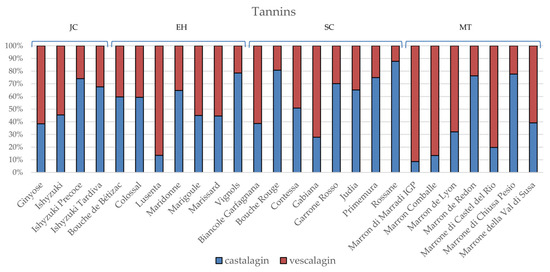
Figure 5.
Distinction of the two tannin components in 26 chestnut cultivars. The lines at the top indicate different groups: “marrone-type” chestnut (MT); sweet chestnut (SC); Euro-Japanese hybrid (EH); Japanese chestnut (JC).
After sugars and organic acids, monoterpenes (Table S2, Figure 6) represented one of the most abundant class of compounds in chestnuts; monoterpenes mostly influence the flavor and intensity of the chestnut aroma during consumption, and they also present specific antioxidant, antibacterial, anti-inflammatory, and anti-cancer activities [41,42]. Consistent with other studies [4,43], the main monoterpene was limonene; in the case of “Ishizuki” and “Ginyose” cv, this molecule represented all the detected aromatic compounds. Some cultivars were partially characterized by the presence of γ-terpinene (e.g., “Contessa”, “Neirana”, “Tarvisò”, and “Maridonne” cv). Phellandrene and sabinene were often detected, but at a very low level, especially in Japanese chestnuts. The Euro-Japanese hybrids also presented low levels in terpenes, except for “Vignols” cv (901.68 ± 4.21 mg 100 g−1 DW), followed by “Maridonne”. The European chestnuts were the most aromatic group, with very high values in “Tarvisò”, “Longal”, and “Garrone Rosso” cv. Some studies showed that the aromatic properties of foods depend not only on the presence of single volatile compounds or on their levels, but it may be due to the synergistic and additive effects of these molecules (e.g., terpenes, terpenoids, organic acids, etc.) on the odor and aroma receptors in humans. For these reasons, the good aromatic properties of sweet chestnuts, if compared to other genotypes, may be due to specific terpenic and organic compounds and to their combination in the nuts [16,44,45]. In some cultivars (e.g., “Dorée de Lyon”, “Gentile”, and “Rossane”), no high content was detected. Although the content was lower than sweet chestnuts, good levels were obtained in the “marrone-type” cultivars, in particular, in “Marrone di Castel del Rio” (530.06 ± 25.98 mg 100 g−1 DW).
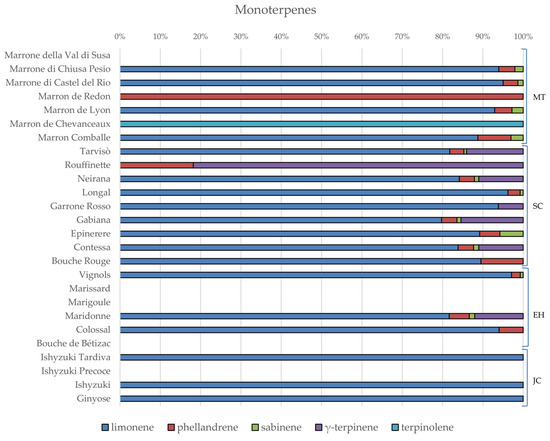
Figure 6.
Monoterpene profile of the selected 26 chestnut cultivars. The lines to the right indicate different groups: “marrone-type” chestnut (MT); sweet chestnut (SC); Euro-Japanese hybrid (EH); Japanese chestnut (JC).
In this study, vitamin C content (Table S2) mainly referred to the oxidized form (dehydroascorbic acid, DHAA), whereas ascorbic acid (AA) was only detected in a few cases (e.g., some “marrone-type” chestnuts and in the Euro-Japanese hybrid cultivar “Lusenta”). De Vasconcelos et al. [24] showed a similar significant decrease in ascorbic acid during the processing steps, whereas dehydroascorbic acid was less involved in this process. Other studies have verified and confirmed that the vitamin C content decreases after drying. The amount detected by Nguyen [46] in the fresh fruit of C. sativa was reduced by more than 30% after drying at 50 °C, and more than 40% after storage in sealed plastic bags at 30 °C for 12 months. In the present work, “Ishizuki Precoce” was the only Japanese cultivar with a quantified amount of vitamin C (7.40 ± 0.26 mg 100 g−1 DW). However, the highest levels were observed in the Euro-Japanese hybrid “Vignols” cv (12.32 ± 0.01 mg 100 g−1 DW), followed by “Lusenta”. For C. sativa cultivars, the results were very heterogeneous: “Dorèe de Lyon” (6.87 ± 0.09 mg 100 g−1 DW), “Savoye”, and “Toumive” presented good amounts; no vitamin C was detected in “Biancole”; and the “Contessa”, “Neirana”, and “Ruiana” cv. “Marrone-type” cultivars showed higher mean values than European chestnuts, with a maximum in “Marrone di Chiusa Pesio” (7.62 ± 0.41 mg 100 g−1 DW). The vitamin C values were similar to the walnut and almond ones [47,48].
Table S3 in the Supplementary Materials reports the nutritional properties of the chestnut extracts.
The composition of the organic acids (Figure 7) was highly variable and specific to each cultivar. In general, the least abundant compounds were oxalic and tartaric acids. The mean amounts in Japanese cultivars and sweet European chestnuts were similar (727.33 and 758.16 mg 100 g−1 DW, respectively) and lower than Euro-Japanese hybrids (1012.98 mg 100 g−1 DW) and “marrone-type” (939.29 mg 100 g−1 DW). The Euro-Japanese hybrid “Precoce Migoule” cv showed the highest content (1879.03 ± 4.06 mg 100 g−1 DW), as reported by Beccaro et al. [4], and other important amounts were detected in “Marsol”, “Vignols”, and “Marissard” cv. Moreover, the group of European chestnuts showed a very wide range between the maximum value (1449.85 ± 0.66 mg 100 g−1 DW in “Laguepie”) and the minimum one (172.38 ± 55.48 mg 100 g−1 DW in “Gentile”). Other varieties rich in organic acids were “Rouffinette”, “Primitiva di Roccamonfina”, and “Toumive”, whereas “Judia” and “Tempuriva” were similarly detected in trace amounts. Gonçalves et al. [49] reported 146 ± 11.1 mg 100 g−1 DW for citric acid and 384 ± 4.02 mg 100 g−1 DW for malic acid in the “Judia” cultivar, a higher value than the levels detected in this study, as well as for in “Longal” cv. In this case, the method of extraction may be an important factor influencing the organic acid content. The “marrone-type” chestnuts also showed a good number of organic acids, especially in “Marrone della Valle di Susa” (1809.85 ± 70.63 mg 100 g−1 DW), “Marrone della Val Pellice”, and “Marron Sauvage”. Organic acids are antioxidant molecules, sometimes used in pharmacological trials, as shown by some studies [50]; these compounds, together with fiber, can synergistically exert a biological action to maintain the digestive system in good health conditions. They increase the bioavailability of mineral elements (e.g., iron and calcium) in the diet. In particular, high levels of quinic acid may be metabolized to hippuric acid, which is useful to alleviate infections in the urinary tracts [51], whereas citric acid plays an important role in regulating the functioning of the urinary tract by inhibiting the adhesion of calcium oxalate crystals to renal epithelial cells [52]. Although the content of organic acids and their profile may well discriminate between different cultivars based on genotype, this variability may be also due to other factors: indeed, the levels of organic acids, as other volatile compounds, are influenced by conservation methods, drying, and extraction protocols [53].
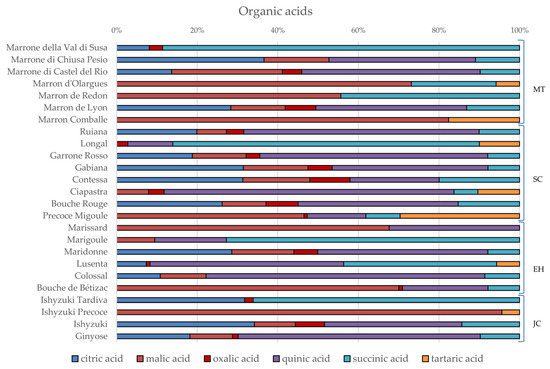
Figure 7.
Organic acids profile of the selected 26 chestnut cultivars. The lines to the right indicate different groups: “marrone-type” chestnut (MT); sweet chestnut (SC); Euro-Japanese hybrid (EH); Japanese chestnut (JC).
This study confirmed that sucrose was the main component of the sugar class (Figure 8), in accordance with previous studies [3,25,54]. However, sucrose was not quantified in “Tsukuba”, “Colossal”, “Bouche Rouge”, and “Marrone di Castel del Rio”, probably due to hydrolysis during the storage. Neri et al. [54] identified 14.96 ± 0.46 g 100 g−1 DW for sucrose, 2.22 ± 0.21 g 100 g−1 DW for fructose, and traces of glucose. Glucose and fructose were always detected in the analyzed extracts. A predominance of fructose over glucose was only observed in a few European cultivars, such as “Bouche Rouge”, “Marrone di Chiusa Pesio”, “Garrone Rosso”, and “Gabiana”. This trait was relevant to define some chestnut cultivars as a potential functional food for consumers with type-2 diabetes because fructose presents a lower glycemic index than glucose, allowing better control of the insulin response and keeping a lower postprandial glycemic peak [55]. C. sativa cultivars and Euro-Japanese hybrids showed a similar range of sugar content (maximum values: 51.83 ± 0.02 g 100 g−1 DW for the hybrid “Vignols”, 57.19 ± 3.74 g 100 g−1 DW for the sweet chestnut “Pugnenga”, and 52.43 ± 2.52 g 100 g−1 DW for “Marron de Redon”). The group with the lowest sugar content was the Japanese chestnuts. The chestnuts presented higher values compared to the sugar levels of other tree nuts such as walnuts and almonds [56,57].
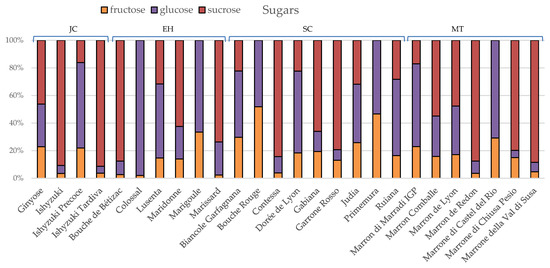
Figure 8.
Sugar profile of the 26 selected chestnut cultivars. The lines at the top indicate different groups: “marrone-type” chestnut (MT); sweet chestnut (SC); Euro-Japanese hybrid (EH); Japanese chestnut (JC).
3.3. Multivariate Analysis
PCA is a tool to reduce multidimensional data, such as chemical fingerprinting, to lower dimensions with minimal loss of information. Many applications are often associated with chemical characterization, such as classification and clustering; PCA is a useful tool for identifying patterns and estimating missing data. These applications may improve traceability and quality control, as well as be used as preliminary tools for genetic analysis. In this study, the main aim was to use phytochemical data and create a multivariate statistical tool to be applied to unknown chestnuts to define their genotype (“species” level).
A PCA for each chestnut group was performed (three repetitions per cultivar), as shown in Figure 9, to create a reliable final model. The five cultivars that were more clustered to the plot center were selected as the most representative of the group.
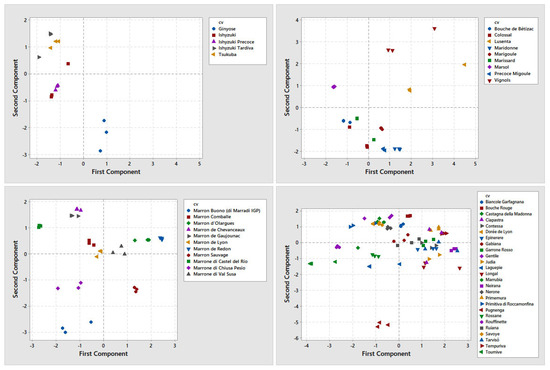
Figure 9.
Principal component analysis (PCA) score plots of the four groups of analyzed chestnuts. Three repetitions were considered for each cultivar. From the left, on the top, Japanese chestnuts (total variance: 91.9%) and Euro-Japanese hybrids (total variance: 75.8%) are shown; on the bottom, “marrone-type” (total variance: 66.9%) and sweet chestnuts (total variance: 62.4%) of the European cultivars. Total variance was reported for eigenvalues greater than or equal to 1.
The score plot of the Japanese chestnuts showed that the cultivars were rather clustered, indicating a low phytochemical variability. However, “Ginyose” cv was described by specific traits compared to the other ones, due to its high content of polyphenolic components, especially catechins and benzoic acids. The distribution of Euro-Japanese hybrids showed that “Lusenta” and “Vignols” cv were not related to other cultivars in the same group. For this reason, “Bouche de Bétizac”, “Colossal”, “Maridonne”, “Marigoule”, and “Marissard” cv were selected, as they are most closely clustered on the plot. The less representative cultivar for European sweet chestnuts was “Pugnenga”, maybe due to its higher sugar and cinnamic acid content than the other cultivars, whereas Portuguese chestnuts (“Judia” and “Longal” cv) presented a similar phytochemical profile. “Contessa”, “Gabiana”, “Garrone Rosso”, “Ruiana”, and “Savoye” cv were placed by the PCA in the most central part of the score plot. In the group of “marrone-type” cultivars, the varieties from Central Italy (“Marrone di Marradi” and “Marrone di Castel del Rio”) were the most different. The French ones were mainly placed in the upper part of the distribution, except “Marron Sauvage” cv, which was more similar to “Marrone della Val Pellice” cv. The most representative cultivars were “Marron Comballe”, “Marron de Lyon”, “Marron de Redon”, “Marrone di Chiusa Pesio”, and “Marrone della Val di Susa”.
The phytochemical data of the selected cultivars were then analyzed as variables by an overall PCA, building the final model to discriminate the different chestnut genotypes (Figure 10).
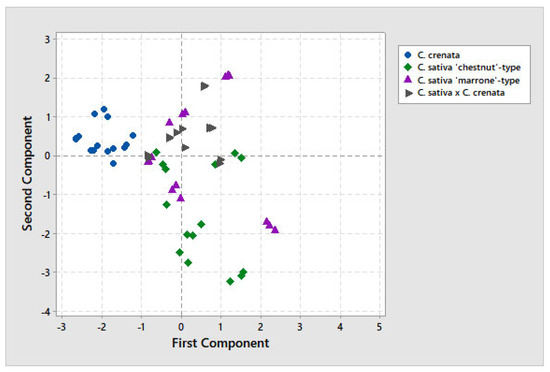
Figure 10.
Distribution of the most representative cultivars (three repetitions) for each group in the principal components plane. Blue color: Japanese chestnut (“Ginyose”, “Ishizuki”, “Ishizuki Precoce”, “Ishizuki Tardiva”, “Tsukuba”); green color: sweet chestnuts (“Contessa”, “Gabiana”, “Garrone Rosso”, “Ruiana”, “Savoye”); fuchsia color: “marrone-type” chestnuts (“Marron Comballe”, “Marron de Lyon”, “Marron de Redon”, “Marrone di Chiusa Pesio”, “Marrone della Val di Susa”); grey color: Euro-Japanese hybrids (“Bouche de Bétizac”, “Colossal”, “Maridonne”, “Marigoule”, “Marissard”).
The identified four principal components (PCs) represented 75% of the total variance with eigenvalues greater than or equal to 1 (from PC1 to PC4. the contribution was 27.1%, 21.3%, 14.3%, and 12.3%, respectively) (Figure 10 and Figure 11). Then, the components were simplified to the main two PCs, maintaining almost 50% of the total variance; PC1 showed a correlation with the content of cinnamic acids, vitamin C, tannins, and catechins, whereas PC2 was related to flavonols, monoterpenes, and benzoic acids. In the loading plot (Figure 11), the phytochemical classes are displayed as vectors in the PCA plane.
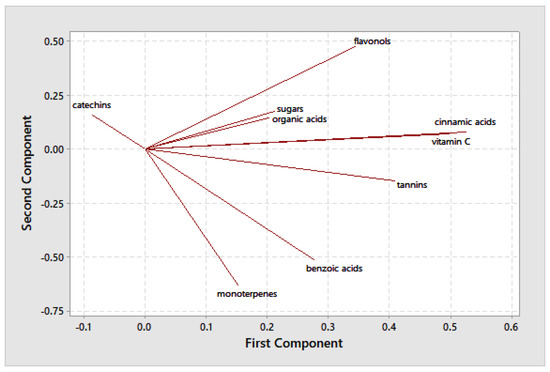
Figure 11.
PCA loading plot of considered variables.
Based on the obtained score plot (Figure 10), the different Castanea species were distributed along the horizontal axis (PC1): C. crenata cultivars were on the left of the plot, the European chestnuts (“chestnut-type” and “marrone-type”) on the right, and Euro-Japanese hybrids in the middle. This distribution is associated with the content of vitamin C (increasing to the right) and the composition of cinnamic acids and tannins. The cultivars belonging to the same species were vertically distributed (PC2); therefore, variables related to PC2 were more discriminant for intraspecific characterization, especially benzoic acids and flavonols for the group of “marrone-type” cultivars. The spatial placement suggested that Euro-Japanese hybrids were more similar to the European chestnuts than to the Japanese chestnuts in terms of chemical profile. Since the aim of the breeding work was to obtain genotypes with improved disease tolerance, maintaining nut quality comparable to that of the European chestnuts [58], this result seems to be a validation of this purpose. Furthermore, the PCA plots provided information about specific biomarkers for each group: “marrone-type” cultivars and Euro-Japanese hybrids presented higher sugar content, Japanese cultivars were mainly characterized by catechins content, and European sweet chestnuts were mainly characterized by monoterpenes content.
Some unknown or unsafe cultivars, always collected in the germplasm repository of the Chestnut R&D Center, were considered and then added to the model to test its effectiveness; the results of morphological and genetic analysis confirmed the genotype reported by the placement in the score plot. For example, the sample O14, defined as “Ishizuki Precoce” cv, was placed on the top right in the PCA score plot, not in the C. crenata group, even if amounts of some bioactive compounds were consistent with the chemical profile of the other C. crenata cultivars. This result confirmed that the evaluation of single markers is not enough to distinguish cultivars with an unknown origin, but it is necessary for a multivariate evaluation. Further genetic analysis proved that this sample did not match with the “Ishizuki Precoce” cv, supporting the efficacy of the statistical multivariate model. Moreover, unsafe samples B4 and T11, incorrectly reported as C. sativa “chestnut-type” cultivars in the list of Chestnut R&D Center, were included in the Euro-Japanese group by the PCA model. This result was confirmed by the morphological and genetic analysis. Finally, sample O2 (described as C. sativa “chestnut-type” in the list) and samples V7, W6, and X3 (reported as C. sativa “marrone-type” in the list) were confirmed in their original description both by the PCA model and morpho-genetic analysis. In any case, further unknown or unsafe cultivars will be tested in the future to confirm these preliminary results.
4. Conclusions
The findings of this study on the phytochemical composition and nutritional properties of different chestnut cultivars provided valuable insights into the potential health benefits and functional traits of chestnuts. The high values of total polyphenolic content (TPC) and antioxidant capacity (AOC) confirmed good levels of bioactive compounds, in particular, phenolics. Both for TPC and AOC, C. crenata showed lower levels than other cultivars; however, Euro-Japanese hybrids presented amounts similar to European chestnuts. Catechins, cinnamic acids, and tannins were the main polyphenols, with a critical role as a tool to distinguish the different varieties. Benzoic acids were only represented by ellagic acid, and they were the class that mostly differentiated the cultivars within the “marrone-type” group. This latter chestnut group presented a lower quantity of tannins than the other groups. In general, castalagin strongly differentiated the cultivars, whereas vescalagin was not defined as a good marker. Similar to sugars and organic acids, monoterpenes represented one of the most abundant classes of compounds in chestnuts, mainly limonene, with European chestnuts being the most aromatic. Good levels of vitamin C were also quantified.
Principal component analysis (PCA) was applied to reduce multidimensional data and identify specific patterns within the chestnut species and hybrids, defining a statistical model to evaluate the different chestnut groups based on phytochemical composition. Clusters among species and hybrids were primarily associated with cinnamic acids, vitamin C, tannins, and catechins, whereas flavonols, monoterpenes, and benzoic acids were more discriminant for intraspecific characterization. Moreover, the PCA was also useful to identify specific biomarkers for each group. The final PCA model was also integrated with unknown or unsafe cultivars from the Chestnut R&D Center to test its effectiveness as a multivariate statistical tool. The genotype suggested by the placement in the PCA plot was confirmed by morphological and genetic analysis. Moreover, this approach demonstrated the value of a multivariate evaluation rather than a single marker discrimination.
However, further studies on the relationships among the main phytochemicals will be necessary to define the structure of predictive screening models for the differentiation of chestnut cultivars of unknown origin, which may allow reducing the number of samples to be subjected to genetic analysis, saving costs and time. By analyzing many cultivars grown under the same pedoclimatic conditions and on the same rootstock, this study confirmed the hypothesis that the genotype plays an important role in chemical composition. These findings highlight the potential for the valorization of chestnut quality by improving the traceability of production and ecotype characterization and contributing to the preservation of agrobiodiversity within the Castanea genus.
Supplementary Materials
The following supporting information can be downloaded at https://www.mdpi.com/article/10.3390/app132212524/s1: Figure S1: Total polyphenol content of the 54 chestnut cultivars; Figure S2: Antioxidant activity of the 54 chestnut cultivars; Table S1: Chromatographic conditions of the used methods; Table S2: Chestnut phytochemical class profiles; Table S3: Nutritional properties of analyzed chestnut cultivars.
Author Contributions
Conceptualization, D.D. and G.L.B.; methodology, D.D.; validation, D.D., E.P., G.G. and M.G.M.; formal analysis, E.P. and D.D.; investigation, E.P. and D.D.; resources, M.G.M. and G.G.; data curation, D.D. and E.P.; writing—original draft preparation, E.P. and D.D.; writing—review and editing, D.D., G.G. and G.L.B.; supervision, G.L.B.; project administration, G.L.B. and M.G.M.; funding acquisition, G.L.B. All authors have read and agreed to the published version of the manuscript.
Funding
This research received no external funding.
Data Availability Statement
The data presented in this study are available in Supplementary Materials.
Acknowledgments
The authors thank the Chestnut R&D Center—Piemonte for providing plant material.
Conflicts of Interest
The authors declare no conflict of interest.
References
- Mellano, M.G.; Beccaro, G.L.; Donno, D.; Torello Marinoni, D.; Boccacci, P.; Canterino, S.; Cerutti, A.K.; Bounous, G. Castanea spp. biodiversity conservation: Collection and characterization of the genetic diversity of an endangered species. Genet. Resour. Crop Evol. 2012, 59, 1727–1741. [Google Scholar] [CrossRef]
- Beccaro, G.L.; Alma, A.; Boni, I.; Botta, R.; Bussone, M.; Corgnati, M.; Ebone, A.; Gonthier, P.; Locatelli, G.; Malacarne, E.; et al. Chestnut R&D Centre: The strategic project of Piemonte to support the whole chestnut supply chain. Italia For. Mont. 2018, 75, 39–48. [Google Scholar]
- Poljak, I.; Vahčić, N.; Vidaković, A.; Tumpa, K.; Žarković, I.; Idžojtić, M. Traditional Sweet chestnut and hybrid varieties: Chemical composition, morphometric and qualitative nut characteristics. Agronomy 2021, 11, 516. [Google Scholar] [CrossRef]
- Beccaro, G.L.; Donno, D.; Lione, G.G.; De Biaggi, M.; Gamba, G.; Rapalino, S.; Riondato, I.; Gonthier, P.; Mellano, M.G. Castanea spp. Agrobiodiversity Conservation: Genotype Influence on Chemical and Sensorial Traits of Cultivars Grown on the Same Clonal Rootstock. Foods 2020, 9, 1062. [Google Scholar] [CrossRef] [PubMed]
- Alessandri, S.; Krznar, M.; Ajolfi, D.; Ramos Cabrer, A.M.; Pereira-Lorenzo, S.; Dondini, L. Genetic Diversity of Castanea sativa Mill. Accessions from the Tuscan-Emilian Apennines and Emilia Romagna Region (Italy). Agronomy 2020, 10, 1319. [Google Scholar] [CrossRef]
- Nunziata, A.; Ruggieri, V.; Petriccione, M.; De Masi, L. Single Nucleotide Polymorphisms as Practical Molecular Tools to Support European Chestnut Agrobiodiversity Management. Int. J. Mol. Sci. 2020, 21, 4805. [Google Scholar] [CrossRef] [PubMed]
- Pereira-Lorenzo, S.; Ramos-Cabrer, A.M.; Barreneche, T. Database of European chestnut cultivars and definition of a core collection using simple sequence repeats. Tree Genet. Genomes 2017, 13, 114. [Google Scholar] [CrossRef]
- Nardecchia, A.; Presutto, R.; Bucci, R. Authentication of the Geographical Origin of “Vallerano” Chestnut by Near Infrared Spectroscopy Coupled with Chemometrics. Food Anal. Methods 2020, 13, 1782–1790. [Google Scholar] [CrossRef]
- Míguez-Soto, B.; Fernández-Cruz, J.; Fernández-López, J. Mediterranean and Northern Iberian gene pools of wild Castanea sativa Mill. are two differentiated ecotypes originated under natural divergent selection. PLoS ONE 2019, 14, e0211315. [Google Scholar] [CrossRef]
- Jarman, R.; Mattioni, C.; Russell, K.; Chambers, F.M.; Bartlett, D.; Angela Martin, M.; Cherubini, M.; Villani, F.; Webb, J. DNA analysis of Castanea sativa (sweet chestnut) in Britain and Ireland: Elucidating European origins and genepool diversity. PLoS ONE 2019, 14, e0222936. [Google Scholar] [CrossRef]
- Pereira-Lorenzo, S.; Ramos-Cabrer, A.M.; Barreneche, T.; Mattioni, C.; Villani, F.; Díaz-Hernández, B.; Martín, L.M.; Robles-Loma, A.; Cáceres, Y.; Martín, A. Instant domestication process of European chestnut cultivars. Ann. Appl. Biol. 2019, 174, 74–85. [Google Scholar] [CrossRef]
- Martín, M.A.; Mattioni, C.; Cherubini, M.; Villani, F.; Martín, L.M. A comparative study of European chestnut varieties in relation to adaptive markers. Agrofor. Syst. 2017, 9, 97–109. [Google Scholar] [CrossRef]
- Martínez, S.; Fuentes, C.; Carballo, J. Antioxidant Activity, Total Phenolic Content and Total Flavonoid Content in Sweet Chestnut (Castanea sativa Mill.) Cultivars Grown in Northwest Spain under Different Environmental Conditions. Foods 2022, 11, 3519. [Google Scholar] [CrossRef] [PubMed]
- Ciucure, C.T.; Geana, E.I.; Sandru, C.; Tita, O.; Botu, M. Phytochemical and nutritional profile composition in fruits of different sweet chestnut (Castanea sativa Mill.) cultivars grown in Romania. Separations 2022, 9, 66. [Google Scholar] [CrossRef]
- Akbulut, M.; Bozhuyuk, M.R.; Ercisli, S.; Skender, A.; Sorkheh, K. Chemical Composition of Seed Propagated Chestnut Genotypes from Northeastern Turkey. Not. Bot. Horti Agrobot. 2017, 45, 425–430. [Google Scholar] [CrossRef]
- Donno, D.; Mellano, M.G.; Carini, V.; Bergamasco, E.; Gamba, G.; Beccaro, G.L. Application of Traditional Cooking Methods in Chestnut Processing: Effects of Roasting and Boiling on Secondary Metabolites and Antioxidant Capacity in Castanea spp. Fruits. Agriculture 2023, 13, 530. [Google Scholar] [CrossRef]
- Fraga, C.G.; Croft, K.D.; Kennedy, D.O.; Tomás-Barberán, F.A. The effects of polyphenols and other bioactives on human health. Food Funct. 2019, 10, 514–528. [Google Scholar] [CrossRef] [PubMed]
- Kebede, M.; Admassu, S. Application of antioxidants in food processing industry: Options to improve the extraction yields and market value of natural products. Adv. Food Technol. Nutr. Sci. Open J. 2019, 5, 38–49. [Google Scholar] [CrossRef]
- Slinkard, K.; Singleton, V.L. Total phenol analysis: Automation and comparison with manual methods. Am. J. Enol. Vitic. 1977, 28, 49–55. [Google Scholar] [CrossRef]
- Benzie, I.F.F.; Strain, J.J. The Ferric Reducing Ability of Plasma (FRAP) as a Measure of “Antioxidant Power”: The FRAP Assay. Anal. Biochem. 1996, 239, 70–76. [Google Scholar] [CrossRef]
- Pellegrini, N.; Serafini, M.; Colombi, B.; Del Rio, D.; Salvatore, S.; Bianchi, M.; Brighenti, F. Total antioxidant capacity of plant foods, beverages and oils consumed in Italy assessed by three different in vitro assays. J. Nutr. 2003, 133, 2812–2819. [Google Scholar] [CrossRef]
- Donno, D.; Randriamampiona, D.; Andriamaniraka, H.; Torti, V.; Mellano, M.G.; Giacoma, C.; Beccaro, G.L. Biodiversity and traditional medicinal plants from Madagascar: Phytochemical evaluation of Brachylaenaramiflora (DC.) Humbert decoctions and infusions. J. Appl. Bot. Food Qual. 2017, 90, 205–213. [Google Scholar]
- Annunziata, A.; Pascale, P. Consumers’ behaviours and attitudes toward healthy food products: The case of Organic and Functional foods. In Proceedings of the 113th Seminar, Chania, Greece, 3–6 September 2009; European Association of Agricultural Economists: Wageningen, The Netherlands, 2009. [Google Scholar]
- De Vasconcelos, M.C.B.M.; Bennett, R.N.; Rosa, E.A.S.; Ferreira-Cardoso, J.V. Composition of European chestnut (Castanea sativa Mill.) and association with health effects: Fresh and processed products. J. Sci. Food Agric. 2010, 90, 1578–1589. [Google Scholar] [CrossRef] [PubMed]
- Suárez, M.; Galdón, B.; Mesa, D.; Romero, C.; Rodríguez, E. Sugars, Organic Acids and Total Phenols in Varieties of Chestnut Fruits from Tenerife (Spain). Food Nutr. Sci. 2012, 3, 705–715. [Google Scholar] [CrossRef][Green Version]
- Otles, S.; Selek, I. Phenolic compounds and antioxidant activities of chestnut (Castanea sativa Mill.) fruits. Qual. Assur. Saf. Crops Foods 2012, 4, 199–205. [Google Scholar] [CrossRef]
- Xu, Z.; Meenu, M.; Chen, P.; Xu, B. Comparative Study on Phytochemical Profiles and Antioxidant Capacities of Chestnuts Produced in Different Geographic Areas in China. Antioxidants 2020, 9, 190. [Google Scholar] [CrossRef] [PubMed]
- Dinis, L.-T.; Oliveira, M.M.; Almeida, J.; Costa, R.; Gomes-Laranjo, J.; Peixoto, F. Antioxidant activities of chestnut nut of Castanea sativa Mill. (cultivar ‘Judia’) as function of origin ecosystem. Food Chem. 2012, 132, 1–8. [Google Scholar] [CrossRef] [PubMed]
- Ghirardello, D.; Bertolino, M.; Belviso, S.; Dal Bello, B.; Giordano, M.; Rolle, L.; Gerbi, V.; Antonucci, M.; Spigolon, N.; Zeppa, G. Phenolic composition, antioxidant capacity and hexanal content of hazelnuts (Corylus avellana L.) as affected by different storage conditions. Postharvest Biol. Technol. 2016, 112, 95–104. [Google Scholar] [CrossRef]
- Slatnar, A.; Mikulic-Petkovsek, M.; Stampar, F.; Veberic, R.; Solar, A. HPLC-MSn identification and quantification of phenolic compounds in hazelnut kernels, oil and bagasse pellets. Food Res. Int. 2014, 64, 783–789. [Google Scholar] [CrossRef] [PubMed]
- Pereira, J.A.; Oliveira, I.; Sousa, A.; Ferreira, I.C.F.R.; Bento, A.; Estevinho, L. Bioactive properties and chemical composition of six walnut (Juglans regia L.) cultivars. Food Chem. Toxicol. 2008, 46, 2103–2111. [Google Scholar] [CrossRef]
- Uzun, S. Postharvest Quality Traits of Chestnut (Castanea sativa Mill.) Fruit as Affected by Methyl Jasmonate During Cold Storage. Erwerbs-Obstbau 2023, 65, 1453–1462. [Google Scholar] [CrossRef]
- Niki, E. Assessment of antioxidant capacity in vitro and in vivo. Free Radic. Biol. Med. 2010, 49, 503. [Google Scholar] [CrossRef] [PubMed]
- Donno, D.; Mellano, M.G.; De Biaggi, M.; Riondato, I.; Rakotoniaina, E.N.; Beccaro, G.L. New Findings in Prunus padus L. Fruits as a Source of Natural Compounds: Characterization of Metabolite Profiles and Preliminary Evaluation of Antioxidant Activity. Molecules 2018, 23, 725. [Google Scholar] [CrossRef] [PubMed]
- Naveed, M.; Hejazi, V.; Abbas, M.; Kamboh, A.A.; Khan, G.J.; Shumzaid, M.; Ahmad, F.; Babazadeh, D.; FangFang, X.; Modarresi-Ghazani, F.; et al. Chlorogenic acid (CGA): A pharmacological review and call for further research. Biomed. Pharmacother. 2018, 97, 67–74. [Google Scholar] [CrossRef] [PubMed]
- Ku, S.K.; Zhou, W.; Lee, W.; Han, M.S.; Na, M.; Bae, J.S. Anti-inflammatory effects of hyperoside in human endothelial cells and in mice. Inflammation 2015, 38, 784–799. [Google Scholar] [CrossRef] [PubMed]
- Landete, J.M. Ellagitannins, ellagic acid and their derived metabolites: A review about source, metabolism, functions and health. Food Res. Int. 2011, 44, 1150–1160. [Google Scholar] [CrossRef]
- Bernatoniene, J.; Kopustinskiene, D.M. The Role of Catechins in Cellular Responses to Oxidative Stress. Molecules 2018, 23, 965. [Google Scholar] [CrossRef]
- Buzzini, P.; Arapitsas, P.; Goretti, M.; Branda, E.; Turchetti, B.; Pinelli, P.; Ieri, F.; Romani, A. Antimicrobial and antiviral activity of hydrolysable tannins. Mini-Rev. Med. Chem. 2008, 8, 1179. [Google Scholar] [CrossRef]
- Hwang, J.Y.; Hwang, I.K.; Park, J.B. Analysis of Physicochemical Factors Related to the Automatic Pellicle Removal in Korean Chestnut (Castanea crenata). J. Agric. Food Chem. 2001, 49, 6045–6049. [Google Scholar] [CrossRef]
- Papaefthimiou, D.; Papanikolaou, A.; Falara, V.; Givanoudi, S.; Kostas, S.; Kanellis, A.K. Genus Cistus: A model for exploring labdane-type diterpenes’ biosynthesis and a natural source of high value products with biological, aromatic, and pharmacological properties. Front. Chem. 2014, 2, 35. [Google Scholar] [CrossRef]
- De Cássia da Silveira e Sá, R.; Andrade, L.N.; de Sousa, D.P. A review on anti-inflammatory activity of monoterpenes. Molecules 2013, 18, 1227–1254. [Google Scholar] [CrossRef] [PubMed]
- Mujić, I.; Zivković, J.; Savić, V.; Alibabić, V.; Staver, M.; Jug, T.; Franić, M.; Damijanić, K. Analysis of volatile compounds in chestnut using solid-phase microextraction coupled with GC-MS. Acta Hortic. 2018, 1220, 203–207. [Google Scholar] [CrossRef]
- Grygorieva, O.V.; Klymenko, S.V.; Teslyuk, M.G.; Onyschuk, L.M. Variability of morphological parameters and determination of volatile organic compounds of sweet chestnut (Castanea sativa Mill.) genotypes fruits. Introdukcija Roslin 2018, 2, 74–83. [Google Scholar]
- Santos, M.J.; Pinto, T.; Vilela, A. Sweet chestnut (Castanea sativa Mill.) nutritional and phenolic composition interactions with chestnut flavor physiology. Foods 2022, 11, 4052. [Google Scholar] [CrossRef] [PubMed]
- Nguyen, M.P. Ascorbic Acid and Total Phenolic Contents of Dried Roasted Chestnut (Castanea sativa) Affected by Drying, Roasting and Preservation. Biosc. Biotech. Res. Comm. 2020, 13, 129–133. [Google Scholar] [CrossRef]
- Alasalvar, C.; Shahidi, F. Tree Nuts: Composition, Phytochemicals, and Health Effects; CRC Press: Boca Raton, FL, USA, 2008. [Google Scholar]
- Alasalvar, C.; Bolling, B.W. Review of nut phytochemicals, fat-soluble bioactives, antioxidant components and health effects. Br. J. Nutr. 2015, 113, S68–S78. [Google Scholar] [CrossRef] [PubMed]
- Gonçalves, B.; Borges, O.; Costa, H.S.; Bennett, R.N.; Santos, M.; Silva, A.P. Metabolite composition of chestnut (Castanea sativa Mill.) upon cooking: Proximate analysis, fibre, organic acids and phenolics. Food Chem. 2010, 122, 154–160. [Google Scholar] [CrossRef]
- Eyduran, S.P.; Ercisli, S.; Akin, M.; Beyhan, O.; Gecer, M.K.; Eyduran, E.; Erturk, Y.E. Organic acids, sugars, vitamin C, antioxidant capacity and phenolic compounds in fruits of white (Morus alba L.) and black (Morus nigra L.) mulberry genotypes. J. Appl. Bot. Food Qual. 2015, 88, 134–138. [Google Scholar]
- Spiller, G.A.; Story, J.A.; Furumoto, E.J.; Chezem, J.C.; Spiller, M. Effect of tartaric acid and dietary fibre from sun-dried raisins on colonic function and on bile acid and volatile fatty acid excretion in healthy adults. Br. J. Nutr. 2003, 90, 803–807. [Google Scholar] [CrossRef]
- Sheng, X.; Jung, T.; Wesson, J.A. Adhesion at calcium oxalate crystal surfaces and the effect of urinary constituents. Proc. Natl. Acad. Sci. USA 2005, 102, 267–272. [Google Scholar] [CrossRef]
- Delgado, T.; Pereira, J.A.; Ramalhosa, E.; Casal, S. Comparison of different drying methods on the chemical and sensory properties of chestnut (Castanea sativa M.) slices. Eur. Food Res. Technol. 2017, 243, 1957–1971. [Google Scholar] [CrossRef]
- Neri, L.; Dimitri, G.; Sacchetti, G. Chemical composition and antioxidant activity of cured chestnuts from three sweet chestnut (Castanea sativa Mill.) ecotypes from Italy. J. Food Compos. Anal. 2010, 23, 23–29. [Google Scholar] [CrossRef]
- Lamothe, L.M.; Lê, K.A.; Samra, R.A.; Roger, O.; Green, H.; Macé, K. The scientific basis for healthful carbohydrate profile. Crit. Rev. Food Sci. Nutr. 2019, 59, 1058–1070. [Google Scholar] [CrossRef] [PubMed]
- Köksal, A.I.; Artik, N.; ¸Simsek, A.; Günes, N. Nutrient composition of hazelnut (Corylus avellana L.) varieties cultivated in Turkey. Food Chem. 2006, 99, 509–515. [Google Scholar] [CrossRef]
- Moodley, R.; Kindness, A.; Jonnalagadda, S.B. Elemental composition and chemical characteristics of five edible nuts (almond, Brazil, pecan, macadamia and walnut) consumed in Southern Africa. J. Environ. Sci. Health Part B 2007, 42, 585–591. [Google Scholar] [CrossRef] [PubMed]
- Pereira-Lorenzo, S.; Costa, R.; Anagnostakis, S.; Serdar, U.; Yamamoto, T.; Saito, T.; Ramos-Cabrer, A.; Ling, Q.; Barreneche, T.; Robin, C.; et al. Interspecific hybridization of chestnut. Polyploidy Hybrid. Crop Improv. 2016, 15, 377–408. [Google Scholar]
Disclaimer/Publisher’s Note: The statements, opinions and data contained in all publications are solely those of the individual author(s) and contributor(s) and not of MDPI and/or the editor(s). MDPI and/or the editor(s) disclaim responsibility for any injury to people or property resulting from any ideas, methods, instructions or products referred to in the content. |
© 2023 by the authors. Licensee MDPI, Basel, Switzerland. This article is an open access article distributed under the terms and conditions of the Creative Commons Attribution (CC BY) license (https://creativecommons.org/licenses/by/4.0/).